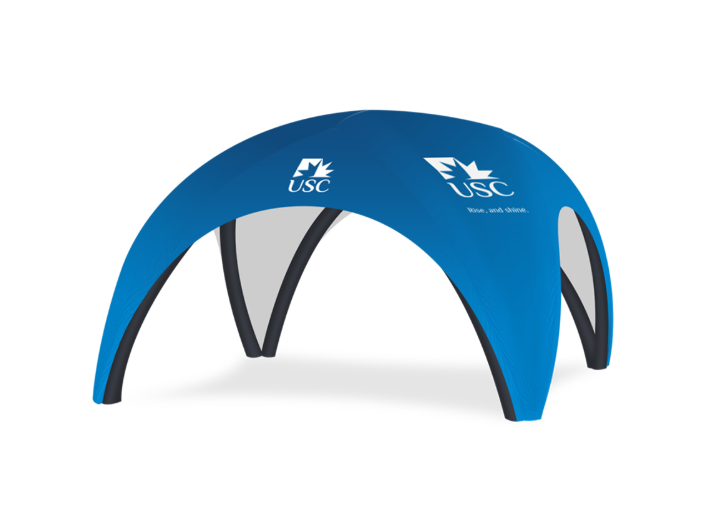Comparing an Air Tent with a Traditional Tent—Which Is Better for Your Next Adventure?

Let’s face it—setting up a tent has tested more friendships, marriages, and family bonds than Monopoly ever could. Between confusing poles, uncooperative fabric, and those tiny clips that never quite fit, it can feel like a battle against your own gear. But then came the air tent—a modern twist that’s promising to make camping setups as easy as inflating a beach ball.
So, should you trade your trusty old pole tent for this futuristic inflatable wonder? Today, we’re diving deep into the ultimate camping showdown: Air Tent vs Traditional Tent. Spoiler alert: by the end, you might find yourself reaching for the pump.
Let’s Talk Setup: Poles vs Pump
Ah, setup—the moment every camper dreads. Traditional tents often come with a pile of poles that look like they belong in a physics experiment. One wrong move and you’re stuck with an upside-down frame or a “leaning tower of canvas.”
In contrast, the air tent laughs in the face of such struggles. No poles, no confusion—just inflate the air beams using a hand or electric pump, and voilà, your home-away-from-home is ready in minutes. Even solo campers can manage it without breaking a sweat.
For families or event organizers who set up multiple shelters, time saved equals more fun (or less chaos). That’s why even companies in the outdoor hospitality business are switching to the best air tents for quick deployment.
Real-life example: A glamping retreat in Colorado swapped their pole tents for air tents, cutting setup time from 45 minutes to under 10. Staff spent less time assembling and more time focusing on guest experiences—a win for efficiency and morale.
Durability: Don’t Let the Air Fool You
Some skeptics hear “inflatable” and imagine a pool toy waiting to pop. But high-quality air tents are built with heavy-duty materials that rival (and often surpass) traditional poles.
Instead of fragile aluminum or fiberglass rods, air tents use robust, multi-layered air beams that flex under pressure rather than snapping. In high winds, this flexibility becomes a superpower—your tent bends gracefully instead of buckling.
Plus, most of the best air tents feature waterproof, UV-resistant fabrics that shrug off rain, wind, and sun like a champ. Pair one with extreme canopies or a large canopy tent for extra protection, and you’ve got a weatherproof fortress.
Take it from an outdoor catering company that recently upgraded its event gear. Their old pole tents often struggled in gusty conditions, but since switching to air tents and extreme canopies, they’ve never lost setup—even during unpredictable mountain weather. Clients noticed the professional look, and bookings soared.
Comfort and Space: Room to Breathe (Literally)
Here’s where air tents really shine. Traditional tents rely on rigid poles that dictate shape and size, limiting how much space you get inside. Air tents, however, use flexible beam structures that allow for taller ceilings, wider interiors, and creative layouts.
You can stand up, stretch out, and even set up separate “rooms” for sleeping, lounging, or gear storage. Some of the best air tents even come with built-in canopies or modular extensions, so you can customize your space depending on your adventure.
Families especially love this feature. Imagine a roomy tent where kids have their own sleeping nook, and parents can finally stand upright without doing yoga poses.
And for businesses that host outdoor events or markets, pairing an air tent with a large canopy tent creates a versatile setup. One section for product displays, another for clients, and a shaded relaxation zone—functionality meets flair.
Portability: Who’s Easier to Carry?
When it comes to packing, traditional tents can feel like you’re lugging a small tree. Between poles, stakes, and fabric, the bags often weigh more than you expected.
Air tents, on the other hand, eliminate the pole bulk. Once deflated, they pack down neatly into a single bag that’s easier to store and transport. For car campers or businesses hauling multiple units, this makes logistics a breeze.
A mobile photography studio that travels to festivals shared their experience after upgrading to air tents. Their old gear took up an entire truckload. Now, they fit three full setups—including extreme canopies and lighting gear—into one vehicle. Fewer trips mean faster setups and less strain on their team.
Maintenance and Repairs: Easier Than You Think
Let’s clear up a misconception: fixing an air tent is surprisingly simple. Most come with repair kits that let you patch small leaks in minutes, like a bike tire. The beams are designed for longevity, and leaks are rare with high-quality models.
Traditional tents, on the other hand, often suffer from bent or broken poles, torn seams, and jammed zippers. Replacement parts can be harder to find and fixing them mid-trip can test anyone’s patience.
If you invest in one of the best air tents, you’re getting materials engineered for durability and easy upkeep—because no one wants to spend their weekend wrestling with repairs.
The Price Tag: Quality Costs, But It Pays Off
Okay, let’s address the elephant in the campground: air tents cost more upfront. But here’s the thing—quality always pays for itself.
A premium air tent can last for years, enduring sun, wind, and rain with minimal wear. Compare that to a budget traditional tent that might need replacing after one rough season, and the investment starts to make sense.
Businesses that rely on canopies and tents—like food vendors, festival organizers, or event planners—understand this better than anyone. Spending a bit more for high-end gear means fewer replacements, better performance, and a polished, professional appearance.
That’s why many successful brands pair best air tents with extreme canopies or large canopy tents for consistent quality across every setup. Clients notice the difference—and so does your bottom line.
Flexibility for Every Occasion
One of the biggest perks of an air tent is its adaptability. From weekend getaways to professional events, it fits a variety of needs.
- Camping trips: Quick setup and spacious interiors make it ideal for families.
- Corporate events: Combine with large canopy tents for branding or guest areas.
- Outdoor markets: Air tents look professional and handle all-day conditions.
- Emergency shelters: Fast deployment is invaluable in disaster-relief scenarios.
Real-life example: A charity organization used the best air tents to create pop-up shelters during a flood-relief effort. Volunteers were able to inflate dozens of units in record time, providing safe, dry spaces for families. The flexibility and strength of these tents proved invaluable during the crisis.
The Verdict: Air Tent or Traditional Tent?
If you’re nostalgic for old-school camping and don’t mind a little setup frustration, a traditional tent can still get the job done. But if you crave convenience, comfort, and modern innovation, the air tent is a clear winner.
It’s faster, more durable, and far more enjoyable to use. And when paired with accessories like extreme canopies or a large canopy tent, it becomes part of a professional-grade outdoor setup fit for adventurers and businesses alike.
Ready to Inflate Your Next Adventure?
Don’t settle for outdated gear that tests your patience. Upgrade to an air tent that’s built for comfort, style, and performance.
Explore our collection of best air tents, extreme canopies, and large canopy tents today. Because when it comes to outdoor adventures—or professional events—quality isn’t just a feature, it’s a necessity.





